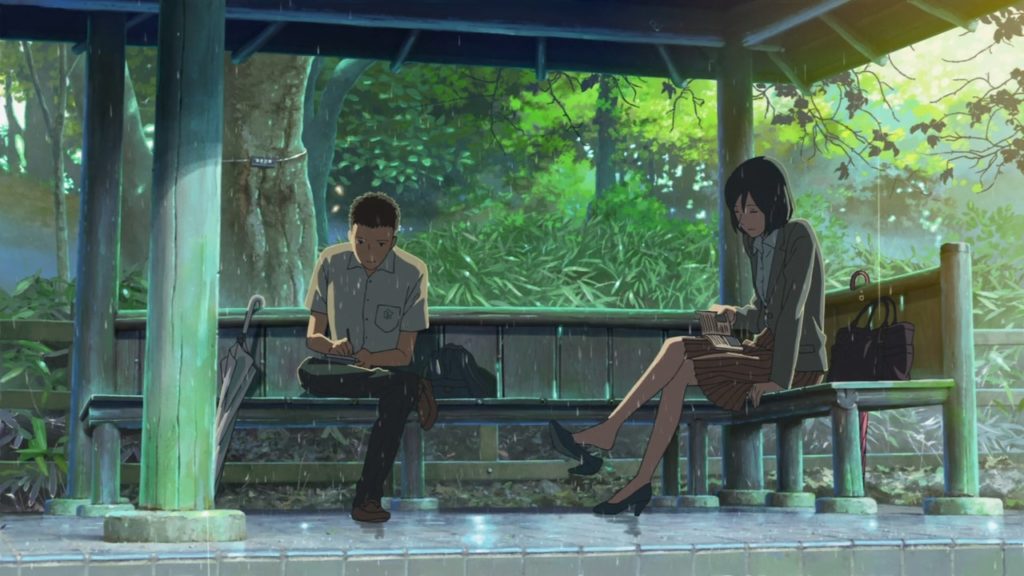Garden of Words
August 27, 2023 · 0 comments
By Tom Arden.

Garden of Words was the last film that Makoto Shinkai made before he was boosted to blockbuster status by Your Name. Set in contemporary Tokyo, it’s the story of a schoolboy, Takao, who’s in the habit of walking through a park on wet days, when the rain gives a magic appearance to the green retreat. There, Takao encounters a strange young woman, Yukino, who captivates the lad. The story follows the pair’s friendship as the rainy season continues, with the most surprising developments…
To celebrate its Blu-ray release as a basic edition, we delve back in time to find an interview with Shinkai from the Edinburgh premiere.
Rain is one of the most important elements in Garden of Words, and it looks incredible. Is it possible to say how much of its creation relied on computer software and simulation, as against the artists’ hands-on input?
It’s hard to give an exact percentage, but maybe it was half computer simulation and half drawings, not just by the animators but by the staff. To be more specific, the droplets of rain in the air are particle simulations, and the rain splashing in puddles and in lakes, the ripples, the spray, that’s hand-drawn.

In Garden of Words, the weather and environment are so important in conveying the characters’ feelings, their deep emotions, that I wondered if the scenery and atmospherics might even be more important than the characters, or the characters’ animation.
I’m glad you said that. I’m very happy if the rain and the background actually left a stronger impression on you than the characters themselves. But this is a commercial anime for the Japanese market, so the characters are of course important, at the centre; 27-year-old Yukino, and 15-year-old Takao. Their feelings are the most important thing, and how the background is used to emphasise those feelings. They’re not all expressed through words and through actions, but maybe through the strength of the rain or the wind. One of the big themes of this work was how to express those emotions through those other elements.
Previous animators have presented rain and storms memorably – for example, in Disney’s Bambi and the short The Old Mill, and in Ghibli’s Totoro. Do you have any comments on them?
I don’t know The Old Mill and I haven’t seen Bambi properly. But I was certainly very aware of Totoro and of Kiki’s Delivery Service when I was making Garden of Words, because of the importance of rain in those films. In Totoro, Satsuki and Mei meet Totoro in the rain. In Kiki, when Kiki is delivering the pie, a storm suddenly springs up. I was very impressed by the use of rain in those films, but they were made in the days of analog. They didn’t use computer animation, so I wanted to see if I could make the rain in Garden of Words look as impressive as in those films, using the computer.

Garden of Words is set in a real place, Shinjuku Park in central Tokyo. I wondered if the settings in your previous films were also real, such as the surfers’ beach in 5 Centimeters per Second and the country town at the beginning of Children Who Chase Lost Voices from Deep Below.
It varies from work to work. The beach and the train stations in 5 Centimeters were real places. The town at the start of Children Who Chase Lost Voices is fictional, though we did location hunts in various places to come up with it. With 5 Centimeters and Garden of Words, those films were all about the emotion, where you have a limited number of characters and it’s about the communication between them. I feel that they need a real location to support the reality of those feelings.
In Japan, some anime fans are interested in real places represented in anime, which they call “Holy Lands.” Have fans treated the settings in your film in that way?
I think so! Garden of Words was actually screened in a Tokyo cinema right next to the Shinjuku park, so there was a sort of pattern that fans would go to see the film, then go to the park. I still live near that park and it’s a place where I often go for a walk, because I like it, not just because we used it in the film. But nowadays fans often approach me in the park, so I try not to go to that particular shelter!

Garden of Words is about a 15 year-old boy; his mother is walking out on the family, and at the same time he’s attracted to an older woman. Some viewers might interpret it as a ‘mother complex’ story, with Yukino representing the mother in the boy’s eyes.
It’s not unrelated, the fact that Takao’s mother has walked out and the fact that he’s attracted to this older woman. But of course the theme of the anime isn’t how to overcome a mother complex, or anything like that! It’s just one element of Takao’s character, one factor that goes into making him.
I read that the shoemaking theme was related to your stay in London, is that correct?
That’s right. When I was creating the character of Takao, I wanted him to have a goal. It could have been to be a novelist, or a manga artist, or a tailor… But as I thought of how I could make it something beautiful, shoes came to mind. One reason was that when I was living in Britain, I met a leather worker, who worked at John Lobb, and I met a Japanese shoemaker, who had come over to study in Britain.
You’ve said that you study the reactions of audiences to your films. How do non-Japanese viewers react?
In general, the reactions to my films overseas tend to be ‘bigger’ than in Japan. People laugh, they clap, they might whistle a bit when Takao says that he thinks that he’s in love with Yukino. They seem to be enjoying themselves, which is a different response to the one you get in Japan.

Regarding Garden of Words, when I’ve asked people afterwards what they thought, a lot of them have said that they want to go to Tokyo, that they didn’t know that there was such a beautiful place as the park in Tokyo. They’ve been very complimentary about the scenery, about the park in particular. Which is nice, because they’re saying nice things about the place I come from!
Given that you’ve lived in London, do you think the story of Garden of Words could work with a London setting and British characters?
First, it would be a chance to draw a completely different kind of beautiful background scenery. London and Edinburgh both have a lot of rain, so the setting is there! But this idea of a female teacher and a young boy who’s twelve years younger than her, and the fact that they don’t get together in the end… I don’t know how realistic it would be in the UK, having grown up in Japan. If everyone here thinks, if the characters like each other that much, they should just get together despite the 12-year age difference, then it might not work, but I don’t know. What do you think?
Er, I’m not sure. It has to be said that recently in Britain, there was a scandal about a relationship between a male teacher and a female teenager [they absconded to France before being found by police].
(Laughs) Well, in terms of morals, a teacher-pupil relationship is not acceptable in Japan either, except maybe after the pupil has left school. So thinking about it, maybe that means the fact that the characters don’t get together in the end would work…

Is it true that the film was available to buy in the Japanese cinemas screening it?
You could buy the film in the cinema, and then three weeks later you could buy it in a regular DVD shop. If people enjoyed what they saw in the cinema and wanted to watch it again at home, they could buy the DVD.
You’ve previously said that the main audience for some of your past films has been young adult males. Did Garden of Words attract a different demographic?
It’s different this time. Depending on the place, some cinemas have had over 50% female audiences. More young people are also coming to see it, of high-school age. So there are more teenagers and more women. But that trend didn’t start with Garden of Words, but with my previous film, Children Who Chase Lost Voices. I really sensed that there were more girls coming to watch that and the film was aimed at younger viewers. So I think that the girls who came to watch Agartha are maybe coming to see Garden of Words as well. So in that respect, making something different to what my current fans expect is important to broaden the fanbase.

You’ve made films with contemporary, realistic settings, and also SF and fantasy films. I wondered whether it helps to alternate between these types; whether, for example, the challenge of making a fantasy helps the next time you make a realistic story. Does one kind of film support the other in a creative way?
Yes, they do support each other. I feel that through making Children Who Chase Lost Voices, I got better at drawing characters. And in the end, whether you’re making a sci-fi film or setting something in the real world, regardless of the genre, it’s always focused on people and feelings. You can use the experience you have in creating a sci-fi film to make a better real-world film, and vice versa. [In his Q&A at Scotland Loves Anime, Shinkai added that Garden of Words’ successmade it likely that his next film would be in the same real-world vein.]
5 Centimeters and Garden of Words culminate with very high emotions, at which point you bring in a big song. Can you comment on this device, and why it appeals to you?
There are several reasons. The main one is that I chose songs that I liked. They’re not new songs, they’re more than ten years old (the one in Garden of Words is a cover of the original). They’re songs that bring back memories for me, and I wanted to use them to tie up the films. Another reason in both cases is that the films are relatively short, and there’s a lot of information and a lot that happens in that short time. The songs are a chance for the audience to have time to think about what they’ve seen and its meaning.
Would you ever consider revisiting the characters you’ve created in Garden of Words in a sequel?
I probably won’t; I wouldn’t mind if someone else wanted to have a go!
Garden of Words is released in the UK in a steelbook edition and new basic edition from Anime Limited.
Leave a Reply